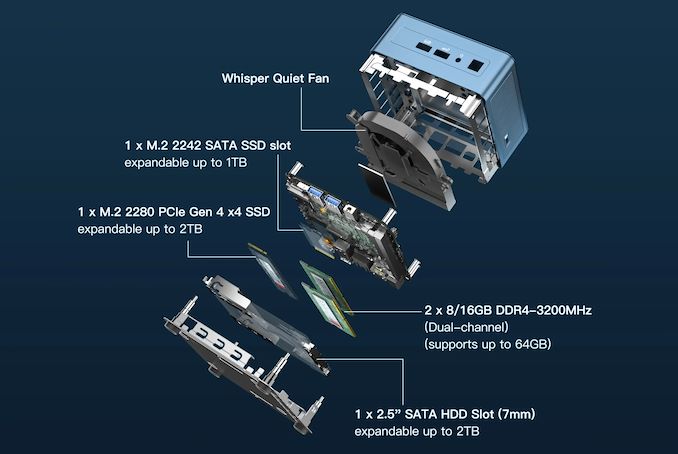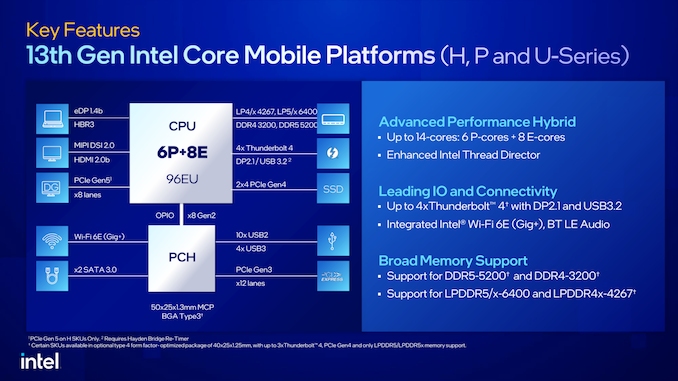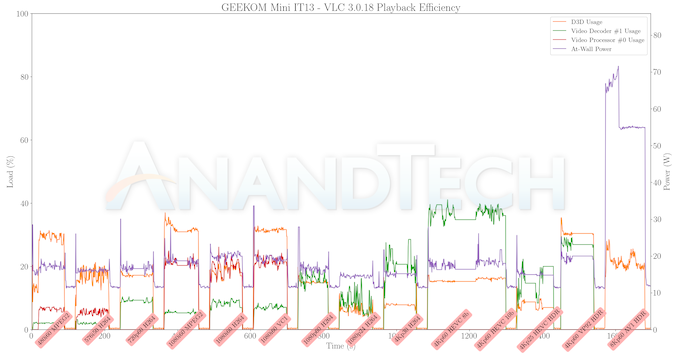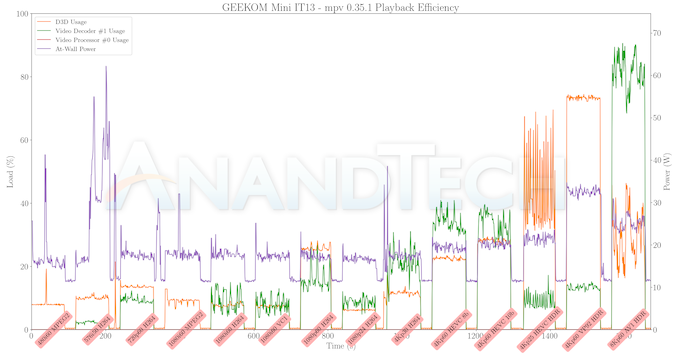
GEEKOM Mini IT13 Review: Core i9-13900H in a 4×4 Package
2023-10-16The performance of ultra-compact form-factor (UCFF) desktops has improved significantly since the introduction of the Intel NUC in the early 2010s. In addition to advancements in semiconductor fabrication and processor architecture, thermal solutions suitable for these 4in. x 4in. machines have also been evolving simultaneously. As a result, vendors have been able to configure higher sustained power limits for the processors in these systems. From the 17W TDP processor used in the first-generation 4×4 NUC, the form-factor moved on to 28W in the late 2010s. The processors in the latest flagship 4×4 NUCs are configured with a 40W sustained power limit.
Intel and AMD have been officially allowing configurable TDPs for their notebook segment offerings for a few years now. This has prompted some vendors to introduce UCFF systems with regular 45W TDP processors (albeit, in cTDP-down mode). GEEKOM became one of the first vendors to release a Core i9-based UCFF machines with the launch of the Mini IT13. Based on paper specifications, this high-end Raptor Lake-H (RPL-H) UCFF desktop is meant to give the mainstream RPL-P NUCs stiff competition in both performance and price.
GEEKOM sent over the flagship configuration – a Mini IT13 equipped with a Core i9-13900H, a 2TB SSD and 32GB of DRAM – to put through our evaluation routine for small form-factor computing systems. This review explores the performance profile and value proposition of the system, along with analysis of the tradeoffs involved in cramming a 45W TDP processor into a 4×4 machine.
The days of bulky desktops are getting numbered for many use-cases, with small form-factor (SFF) systems replacing them. The rapid growth in this segment has led to the rise of many Asian vendors focusing on these systems. GEEKOM is a private label brand of Shenzhen Jiteng Network Technology Co., Ltd. – an OEM / ODM for small form-factor computing systems. The company manufactures both Intel and AMD-based systems. The private label started off with a few entry-level systems (such as the MiniAir 11) , but has since branched out to introduce machines with leading-edge processors. The company had announced the Raptor Lake-H-based Mini IT13 within a few days of the launch of the SimplyNUC Onyx. While the Onyx is still in the pre-order stage, GEEKOM has been selling the Mini IT13 for a few weeks now.
GEEKOM sent over the flagship Mini IT13 configuration for review. The Intel Core i8-13900H processor in the Mini IT13 review system has a six performance cores and eight efficiency cores for a total of 20 threads. Compared to the RPL-P processors used in the flagship mainstream 4×4 NUCs, this RPL-H processor has two extra performance cores and a higher maximum turbo frequency (up to 5.4 GHz, against RPL-P’s maximum 5.0 GHz). The processor is fabricated in the Intel 7 process.
GEEKOM’s package for the Mini IT13 is spartan – the main unit is accompanied by a welcome card, VESA mount with associated screws, an installation guide, HDMI cable, and a 120W (19V @ 6.32A) AC adapter with a geo-specific power cord.
The main unit clocks in at 117mm x 112mm x 49.2mm, with a weight of 652g. The system is sized to accept a 2.5″ drive, and that makes it comparable to the full-height mainstream NUCs such as the NUC13ANHi7 Arena Canyon SKU measuring 117mm x 112mm x 54mm. The larger dimensions allow for a wider variety of ports in the systems compared to regular NUCs.
GEEKOM does not sell barebones versions of the Mini IT13. A SSD, DRAM, and a pre-installed copy of Windows 11 Pro are also provided. In keeping with the premium nature of the Core i8-13900H, the configuration with that CPU includes a 2TB SSD and 32GB of RAM.
Unlike the GEEKOM AS6, the board and chassis design are fairly straightforward and similar to the NUCs.
The DDR4 SODIMM slots and the Gen4 x4 M.2 SSD slots on the motherboard are pre-populated in the GEEKOM configurations. The WLAN / BT module interfaces with the CPU over CNVi and is under the NVMe SSD slot (similar to the mainstream NUCs). There is a metal frame that is built around the 2.5″ drive slot, and a thermal pad is affixed to it to provide heat transfer support from the M.2 2280 NVMe SSD. Our review configuration was equipped with 2x Lexar LD4AS016G-3200ST DDR4-3200 SODIMMs and a Lexar SSD NM7A1 Gen4 x4 M.2 2280 NVMe SSD. Windows 11 Professional came pre-installed.
The full specifications of the review sample (as tested) are summarized in the table below. The Core i9-13900H has a TDP of 45W, and a minimum power (cTDP-down) of 35W. As we shall see in our BIOS options analysis and detailed investigation into the thermal characteristics in a later section, the form-factor of the system and the notebook-style thermal solution restricts the operation of the processor in a 35W cTDP mode.
| GEEKOM Mini IT13 Specifications (as tested) |
|
| Processor | Intel Core i9-13900H Raptor Lake (6P + 8E)/20T, up to 5.4 GHz Intel 7, 24MB L2, 45W (PL1 = 35W, PL2 = 80W) |
| Memory | Lexar LD4AS016G-3200ST DDR4-3200 SODIMM 22-22-22-52 @ 3200 MHz 2×16 GB |
| Graphics | Intel Iris Xe Graphics (80 EUs @ 300 – 1500 MHz) |
| Disk Drive(s) | Lexar SSD NM7A1 (2000 GB; M.2 2280 PCIe 4.0 x4 NVMe;) (176L Micron 3D TLC?; Maxio MAP1602 Controller) |
| Networking | 1x 2.5 GbE RJ-45 (Intel I225-V) Intel Wi-Fi 6E AX211 (2×2 802.11ax ~ 2.4 Gbps) |
| Audio | Digital Audio with Bitstreaming Support over HDMI and USB4 Ports Front panel audio combo jack via Realtek ALC269 |
| Video | 2x DP 2.0 (1.4 certified / 8Kp30) (via USB4 Type-C in the rear) 2x HDMI 2.0 (up to 4Kp60) (rear) |
| Miscellaneous I/O Ports | 2x USB4 (Type-C / 40 Gbps) (Rear) 1x USB 3.2 Gen 2 Type-A (Rear) 1x USB 2.0 Type-A (Rear) 2x USB 3.2 Gen 2 Type-A (Front) 1x SDXC UHS-II Card Reader (Side) |
| Operating System | Windows 11 Enterprise (22000.2416) |
| Pricing | (Street Pricing on Sep 29th, 2023) US $899 (as configured, w/OS) (USD 859 with $40 off coupon code D9ZAYQNX) US $789 (as configured, w/OS, GEEKOM web store) (USD 749 with $40 off coupon code anandtech40) |
| Full Specifications | GEEKOM Mini IT13 Specifications |
The next section details the the various BIOS options and follows it up with a detailed platform analysis.
Our review sample of the GEEKOM Mini IT13 came with all necessary components pre-installed – including the OS. Prior to setting up the OS on first boot, we took some time to look into the BIOS interface. Unlike the GUI-based UEFI interface offered by tier-one vendors, the BIOS here is a vanilla one with keyboard-only navigation. There are plenty of configurable options, and the video below presents an overview of the features.
Most of the options available are standard in the Aptio BIOS interface. In addition to the processor and memory speeds information, the main screen has a ‘FAN Mode’ option that can be set to one of ‘Normal’, ‘Performance’, or ‘Quiet’. A quick check was made for each setting after booting into the OS and the following power limits were recorded.
| PL1 / PL2 Variation with BIOS Setting | |||

While the normal and performance modes were configured similarly with PL1 / PL2 settings of 35W / 80W, the quiet mode involved setting these parameters to 28W / 40W and the PL1 duration to less than half of the normal mode’s.
Intel’s platform diagram for Raptor Lake P/H/U processor lines shows a large number of connectivity options. However, the RPL-H configuration in the Mini IT13 doesn’t make use of the x8 discrete graphics lanes. Two Thunderbolt 4 lanes are used for the Type-C ports, but the use of the Hayden Bridge retimer precludes the possibility of USB 3.2 Gen 2×2 (20 Gbps) support.
The overall high-speed I/O distribution in the GEEKOM Mini IT13 board design is brought out in the bus layout diagram below.
Despite the large number of connectivity options, the system’s form-factor prevent them from getting utilized. The USB4 ports do provide some flexibility. It is highly probable that a few more of those to utilize the wasted graphics PCIe lanes would have made the product even more attractive.
In today’s review, we compare the GEEKOM Mini IT13 and a host of other systems based on processors with TDPs ranging from 28W to 65W. The systems do not target the same market segments, but a few key aspects lie in common, making the comparisons relevant.
| Comparative PC Configurations | ||
| Aspect | GEEKOM Mini IT13 | |
| CPU | Intel Core i9-13900H Raptor Lake (6P + 8E)/20T, up to 5.4 GHz Intel 7, 24MB L2, 45W (PL1 = 35W, PL2 = 80W) |
Intel Core i9-13900H Raptor Lake (6P + 8E)/20T, up to 5.4 GHz Intel 7, 24MB L2, 45W (PL1 = 35W, PL2 = 80W) |
| GPU | Intel Iris Xe Graphics (80 EUs @ 300 – 1500 MHz) |
Intel Iris Xe Graphics (80 EUs @ 300 – 1500 MHz) |
| RAM | Lexar LD4AS016G-3200ST DDR4-3200 SODIMM 22-22-22-52 @ 3200 MHz 2×16 GB |
Lexar LD4AS016G-3200ST DDR4-3200 SODIMM 22-22-22-52 @ 3200 MHz 2×16 GB |
| Storage | Lexar SSD NM7A1 (2000 GB; M.2 2280 PCIe 4.0 x4 NVMe;) (176L Micron 3D TLC?; Maxio MAP1602 Controller) |
Lexar SSD NM7A1 (2000 GB; M.2 2280 PCIe 4.0 x4 NVMe;) (176L Micron 3D TLC?; Maxio MAP1602 Controller) |
| Wi-Fi | 1x 2.5 GbE RJ-45 (Intel I225-V) Intel Wi-Fi 6E AX211 (2×2 802.11ax ~ 2.4 Gbps) |
1x 2.5 GbE RJ-45 (Intel I225-V) Intel Wi-Fi 6E AX211 (2×2 802.11ax ~ 2.4 Gbps) |
| Price (in USD, when built) | (Street Pricing on Sep 29th, 2023) US $899 (as configured, w/OS) (USD 859 with $40 off coupon code D9ZAYQNX) US $789 (as configured, w/OS, GEEKOM web store) (USD 749 with $40 off coupon code anandtech40) |
(Street Pricing on Sep 29th, 2023) US $899 (as configured, w/OS) (USD 859 with $40 off coupon code D9ZAYQNX) US $789 (as configured, w/OS, GEEKOM web store) (USD 749 with $40 off coupon code anandtech40) |
The next few sections will deal with comparative benchmarks for the above systems.
Our 2022 Q4 update to the test suite for Windows 11-based systems carries over some of the standard benchmarks we have been using over the last several years. While UL’s PCMark makes the list, we have opted to temporarily suspend reporting of BAPCo’s SYSmark scores (pending fixture of the energy consumption aspect). Instead, BAPCO’s CrossMark multi-platform benchmarking tool has been added to the set along with UL’s Procyon suite. While CrossMark employs idle time compression and processes all workloads in an opaque manner, UL’s Procyon processes real-world workloads with user interactions (like BAPCo’s SYSmark). We have augmented the UL Procyon suite benchmark with our own custom energy measurement setup.
UL PCMark 10
UL’s PCMark 10 evaluates computing systems for various usage scenarios (generic / essential tasks such as web browsing and starting up applications, productivity tasks such as editing spreadsheets and documents, gaming, and digital content creation). We benchmarked select PCs with the PCMark 10 Extended profile and recorded the scores for various scenarios. These scores are heavily influenced by the CPU and GPU in the system, though the RAM and storage device also play a part. The power plan was set to Balanced for all the PCs while processing the PCMark 10 benchmark. The scores for each contributing component / use-case environment are also graphed below.
| UL PCMark 10 – Performance Scores | |||

Almost all of the 40W Raptor Lake-based systems and the 42W Ryzen-based systems enjoy a significant edge over the 35W PL1 configuration of the Core i9-13900H in the Mini IT13. In certain cases, the two extra performance cores seems to help. Overall the Mini IT13 emerges as an average performer in the Futuremark PCMark benchmark.
UL Procyon v2.1.544
PCMark 10 utilizes open-source software such as Libre Office and GIMP to evaluate system performance. However, many of their professional benchmark customers have been requesting evaluation with commonly-used commercial software such as Microsoft Office and Adobe applications. In order to serve their needs, UL introduced the Procyon benchmark in late 2020. There are five benchmark categories currently – Office Productivity, AI Inference, Battery Life, Photo Editing, and Video Editing. AI Inference benchmarks are available only for Android devices, while the battery life benchmark is applicable to Windows devices such as notebooks and tablets. We presents results from our processing of the other three benchmarks.
| UL Procyon – Office Productivity Scores | |||

The results from the UL Procyon Office Productivity Suite are similar to what was seen for the Essentials suite in PCMark. The Raptor Lake-P systems with a 40W TDP outperform the others (including the Mini IT13 with its 35W processor). The system is able to hold out against the rest, though – including the 65W Phoenix one.

From an energy consumption viewpoint, the Mini IT13 loses out to the Intel NUC (Arena Canyon). For the same energy consumption as the 35W Ryzen 9 6900HX in the GEEKOM AS6, the Mini IT13 is able to deliver better scores. The new Phoenix-based GTR7 with a 65W power limit for the APU ends up with approximately the same score as the Mini IT13, but performs much better on the efficiency front.
Moving on to the evaluation of Adobe Photoshop and Adobe Lightroom, we find that the GPU is utilized more heavily compared to the office workloads. The new RDNA3 iGPU coupled with a 65W power limit catapult the Beelink GTR7 to the top, with the Raptor Lake-P / -H systems following behind. DDR4 vs. DDR5 memory / available memory bandwidth also appears to have a bearing on the ordering in this benchmark.

The GEEKOM Mini IT13 manages to make it to the middle of the pack in the energy consumption aspect. Both the Beelink GTR7 and the ASRock Industrial NUC BOX-1360P/D5 deliver better scores with lesser energy consumption. In this context, the two additional CPU cores and a lower package power limit appear to be responsible for this ordering.
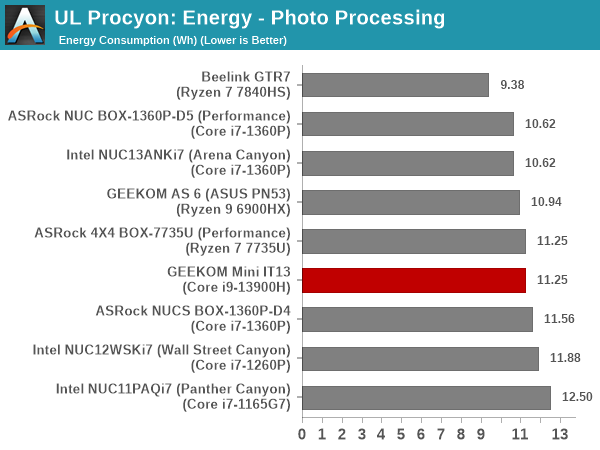
UL Procyon evaluates performance for video editing using Adobe Premier Pro.
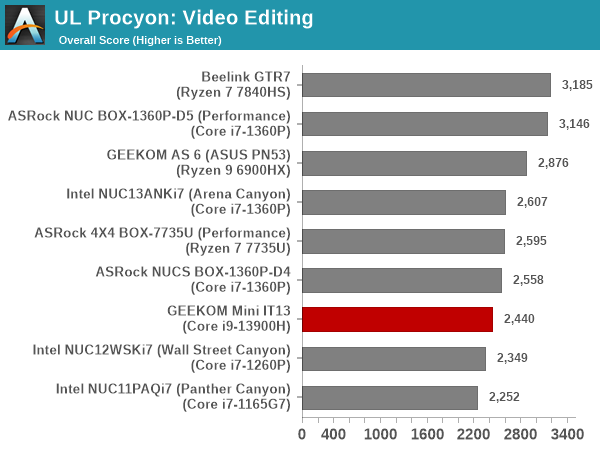
The video editing scores depend on the GPU capabilities and the available power budget. It is no surprise that the Beelink GTR7 with its RDNA3 iGPU and 65W package limit is on top of the charts. With two additional CPU cores compared to the Core i7-1360P in the RPL-P units in a similar power budget (and thus reducing the amount available for the iGPU), the Mini IT13 marks its presence in the lower half of the pack.

The power consumption of the system at load is similar to the other RPL-P systems. As a result, the additional time taken to complete the workload due to the aforementioned reasons contributes negatively to the energy efficiency.
BAPCo CrossMark 1.0.1.86
BAPCo’s CrossMark aims to simplify benchmark processing while still delivering scores that roughly tally with SYSmark. The main advantage is the cross-platform nature of the tool – allowing it to be run on smartphones and tablets as well.
| BAPCo CrossMark 1.0.1.86 – Sub-Category Scores | |||

The presence of two additional high-performance cores (relative to the RPL-P systems) help the Mini IT 13 emerge with top honors despite the lower power budget. Since CrossMark workloads involve idle time compression, the short bursts of higher power also helps the Mini IT13 over other systems with its higher PL2 setting.
SFF PCs traditionally do not lend themselves to workstation duties. However, a recent trend towards miniaturized workstations has been observed. While systems in the GEEKOM Mini IT13’s form-factor are still not capable enough to become workstations, the rapid performance improvements over the years has encouraged us to benchmark some of these UCFF / SFF systems for content creation workloads and professional applications. Towards this, we processed the SPECworkstation 3.1 benchmark from SPEC.
The SPECworkstation 3.1 benchmark measures workstation performance based on a number of professional applications. It includes more than 140 tests based on 30 different workloads that exercise the CPU, graphics, I/O and memory hierarchy. These workloads fall into different categories.
- Media and Entertainment (3D animation, rendering)
- Product Development (CAD/CAM/CAE)
- Life Sciences (medical, molecular)
- Financial Services
- Energy (oil and gas)
- General Operations
- GPU Compute
Individual scores are generated for each test and a composite score for each category is calculated based on a reference machine (HP Z240 tower workstation using an Intel E3-1240 v5 CPU, an AMD Radeon Pro WX3100 GPU, 16GB of DDR4-2133, and a SanDisk 512GB SSD). Official benchmark results generated automatically by the benchmark itself are linked in the table below for the systems being compared.
| SPECworkstation 3.1 Official Results (2K) | |
| GEEKOM Mini IT13 | Run Summary |
| GEEKOM AS 6 (ASUS PN53) | Run Summary |
| Intel NUC12WSKi7 (Wall Street Canyon) | Run Summary |
| ASRock NUC BOX-1360P-D5 (Performance) | Run Summary |
| ASRock 4X4 BOX-7735U (Performance) | Run Summary |
| Beelink GTR7 | Run Summary |
| ASRock NUCS BOX-1360P-D4 | Run Summary |
| Intel NUC11PAQi7 (Panther Canyon) | Run Summary |
| Intel NUC13ANKi7 (Arena Canyon) | Run Summary |
Details of the tests in each category, as well as an overall comparison of the systems on a per-category basis are presented below.
Media and Entertainment
The Media and Entertainment category comprises of workloads from five distinct applications:
- The Blender workload measures system performance for content creation using the open-source Blender application. Tests include rendering of scenes of varying complexity using the OpenGL and ray-tracing renderers.
- The Handbrake workload uses the open-source Handbrake application to transcode a 4K H.264 file into a H.265 file at 4K and 2K resolutions using the CPU capabilities alone.
- The LuxRender workload benchmarks the LuxCore physically based renderer using LuxMark.
- The Maya workload uses the SPECviewperf 13 maya-05 viewset to replay traces generated using the Autodesk Maya 2017 application for 3D animation.
- The 3ds Max workload uses the SPECviewperf 13 3dsmax-06 viewset to replay traces generated by Autodesk’s 3ds Max 2016 using the default Nitrous DX11 driver. The workload represents system usage for 3D modeling tasks.
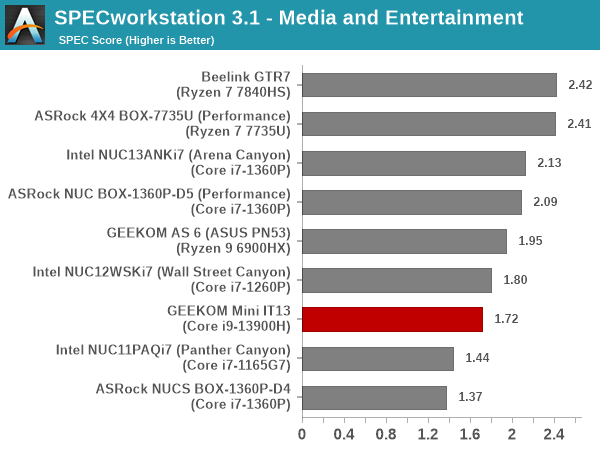
Product Development
The Product Development category comprises of eight distinct workloads:
- The Rodinia (CFD) workload benchmarks a computational fluid dynamics (CFD) algorithm.
- The WPCcfd workload benchmarks another CFD algorithm involving combustion and turbulence modeling.
- The CalculiX workload uses the Calculix finite-element analysis program to model a jet engine turbine’s internal temperature.
- The Catia workload uses the catia-05 viewset from SPECviewperf 13 to replay traces generated by Dassault Systemes’ CATIA V6 R2012 3D CAD application.
- The Creo workload uses the creo-02 viewset from SPECviewperf 13 to replay traces generated by PTC’s Creo, a 3D CAD application.
- The NX workload uses the snx-03 viewset from SPECviewperf 13 to replay traces generated by the Siemens PLM NX 8.0 CAD/CAM/CAE application.
- The Solidworks workload uses the sw-04 viewset from SPECviewperf 13 to replay traces generated by Dassault Systemes’ SolidWorks 2013 SP1 CAD/CAE application.
- The Showcase workload uses the showcase-02 viewset from SPECviewperf 13 to replay traces from Autodesk’s Showcase 2013 3D visualization and presentation application
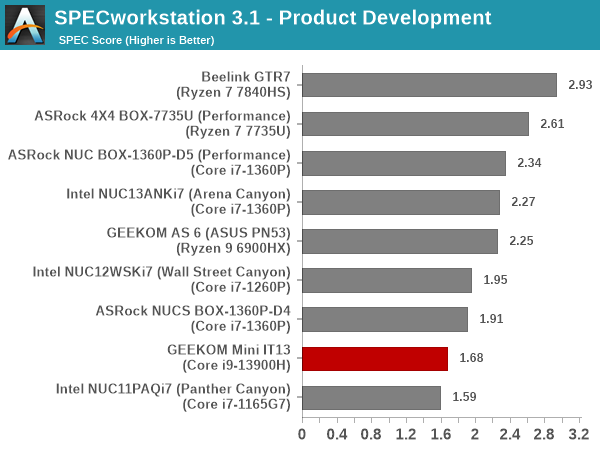
Life Sciences
The Life Sciences category comprises of four distinct test sets:
- The LAMMPS set comprises of five tests simulating different molecular properties using the LAMMPS molecular dynamics simulator.
- The NAMD set comprises of three tests simulating different molecular interactions.
- The Rodinia (Life Sciences) set comprises of four tests – the Heartwall medical imaging algorithm, the Lavamd algorithm for calculation of particle potential and relocation in a 3D space due to mutual forces, the Hotspot algorithm to estimate processor temperature with thermal simulations, and the SRAD anisotropic diffusion algorithm for denoising.
- The Medical workload uses the medical-02 viewset from SPECviewperf 13 to determine system performance for the Tuvok rendering core in the ImageVis3D volume visualization program.

Financial Services
The Financial Services workload set benchmarks the system for three popular algorithms used in the financial services industry – the Monte Carlo probability simulation for risk assessment and forecast modeling, the Black-Scholes pricing model, and the Binomial Options pricing model.

Energy
The Energy category comprises of workloads simulating various algorithms used in the oil and gas industry:
- The FFTW workload computes discrete Fourier transforms of large matrices.
- The Convolution workload computes the convolution of a random 100×100 filter on a 400 megapixel image.
- The SRMP workload processes the Surface-Related Multiples Prediction algorithm used in seismic data processing.
- The Kirchhoff Migration workload processes an algorithm to calculate the back propogation of a seismic wavefield.
- The Poisson workload takes advantage of the OpenMP multi-processing framework to solve the Poisson’s equation.
- The Energy workload uses the energy-02 viewset from SPECviewperf 13 to determine system performance for the open-source OPendTec seismic visualization application.
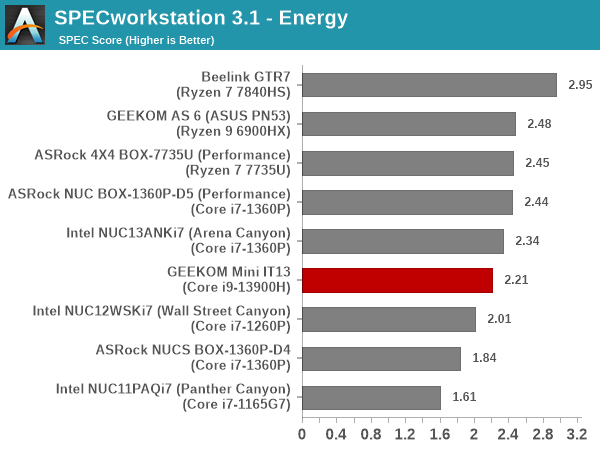
General Operations
In the General Options category, the focus is on workloads from widely used applications in the workstation market:
- The 7zip workload represents compression and decompression operations using the open-source 7zip file archiver program.
- The Python workload benchmarks math operations using the numpy and scipy libraries along with other Python features.
- The Octave workload performs math operations using the Octave programming language used in scientific computing.
- The Storage workload evaluates the performance of the underlying storage device using transaction traces from multiple workstation applications.
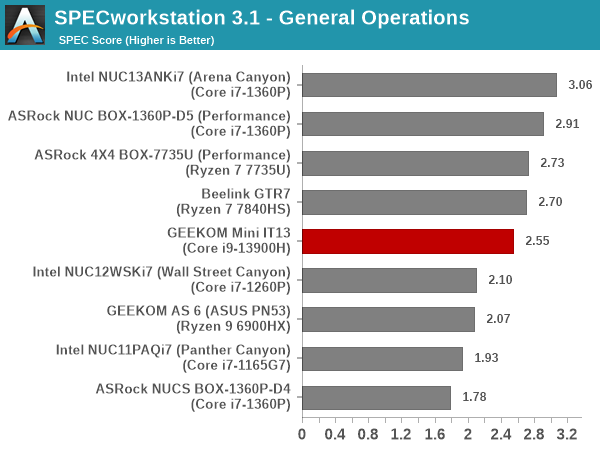
GPU Compute
In the GPU Compute category, the focus is on workloads taking advantage of the GPU compute capabilities using either OpenCL or CUDA, as applicable:
- The LuxRender benchmark is the same as the one seen in the media and entertainment category.
- The Caffe benchmark measures the performance of the Caffe deep-learning framework.
- The Folding@Home benchmark measures the performance of the system for distributed computing workloads focused on tasks such as protein folding and drug design.
We only process the OpenCL variants of the benchmark, as the CUDA version doesn’t process correctly with default driver installs. This workload is a weak point for Intel’s iGPUs, as they can’t complete some of the components successfully.
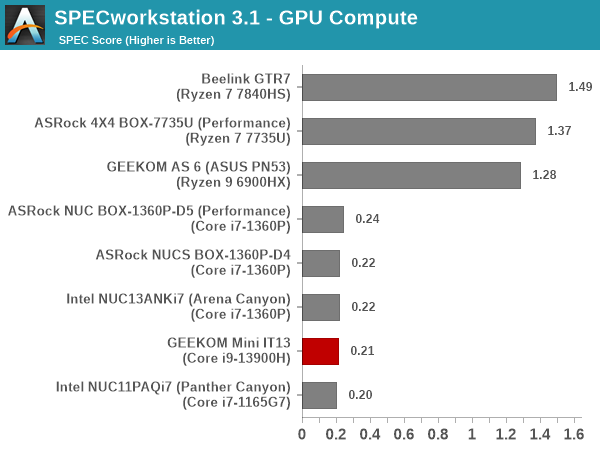
Workloads processed on workstations are long-running tasks that don’t benefit in any meaningful way from higher PL1 numbers. UCFF systems find it difficult to sustain these higher package power numbers for a long enough time to influence the performance in workstation benchmarks. As a result, the relative performance of the GEEKOM Mini IT13 in SPECworkstation v3.1 is dictated by its sustained package power limit of 35W. The presence of two additional high-performance cores over the RPL-P systems lends it some advantage in a few multi-threaded workloads, but these cores are slowed down compared to the RPL-P due to the latter being configured for a 40W PL1 in most of the compared systems. The net result is that the GEEKOM Mini IT13 makes its mark in the bottom half of the pack across almost all workload components.
Standardized benchmarks such as UL’s PCMark 10 and BAPCo’s SYSmark take a holistic view of the system and process a wide range of workloads to arrive at a single score. Some systems are required to excel at specific tasks – so it is often helpful to see how a computer performs in specific scenarios such as rendering, transcoding, JavaScript execution (web browsing), etc. This section presents focused benchmark numbers for specific application scenarios.
3D Rendering – CINEBENCH R23
We use CINEBENCH R23 for 3D rendering evaluation. R23 provides two benchmark modes – single threaded and multi-threaded. Evaluation of different PC configurations in both supported modes provided us the following results.
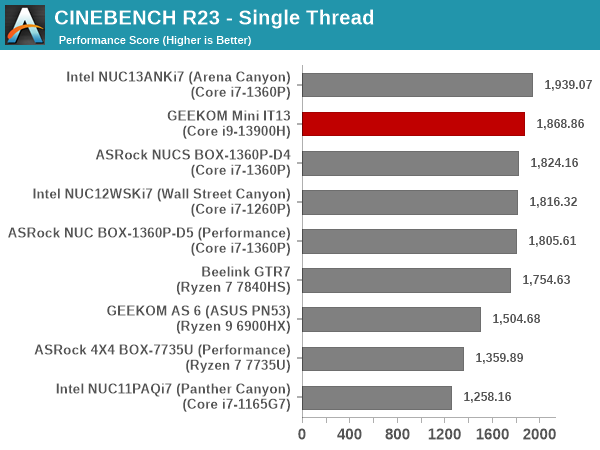
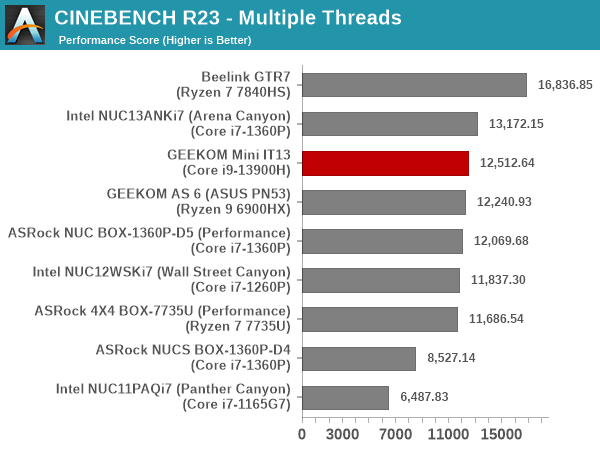
In the single-threaded case, all the Raptor Lake systems perform similar to each other, with different scores being in the realm of run-to-run variations. Tiger Lake comes in last, with the Zen 2 / 3 /4 systems making up the middle. In the multi-threaded case, the AMD-based systems move up the chain. The 65W power budget and the presence of eight of high-performance Zen 4 cores ensure the lead for the Beelink GTR7 by a huge margin, but the 35W PL1 and six high-performance cores help the Mini IT13 retain its place in the top half of the pack.
Transcoding: Handbrake 1.5.1
Handbrake is one of the most user-friendly open source transcoding front-ends in the market. It allows users to opt for either software-based higher quality processing or hardware-based fast processing in their transcoding jobs. Our new test suite uses the ‘Tears of Steel’ 4K AVC video as input and transcodes it with a quality setting of 19 to create a 720p AVC stream and a 1080p HEVC stream.
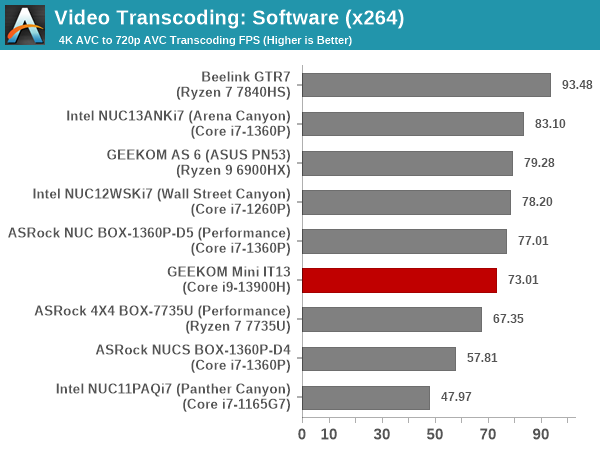
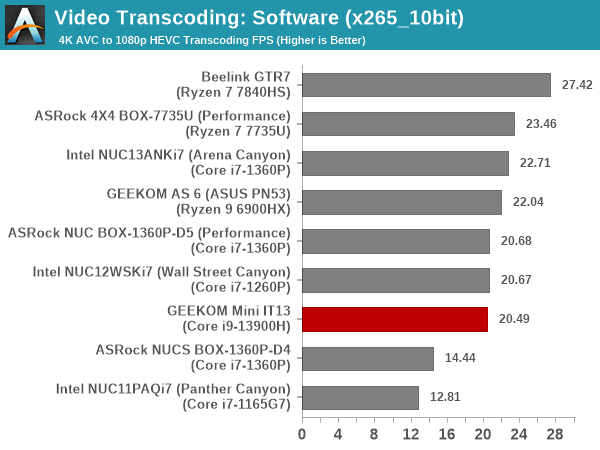
Software transcoding performance depends on the number of available threads and the available power budget. The 35W PL1 setting keeps the Mini IT13 in the bottom half of the pack, despite the two additional cores available over systems like the Wall Street Canyon and Arena Canyon NUCs (which have four performance cores at a 40W PL1).
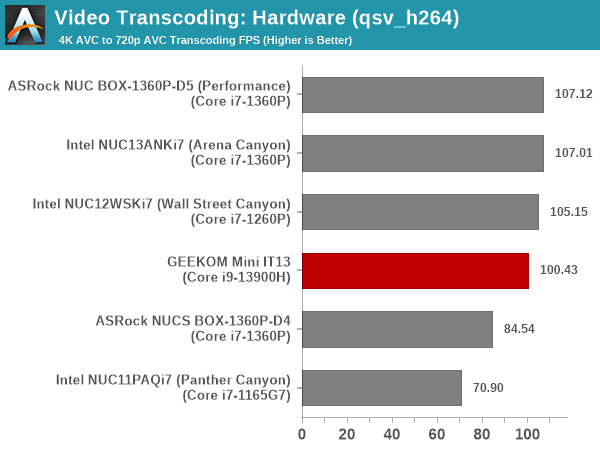
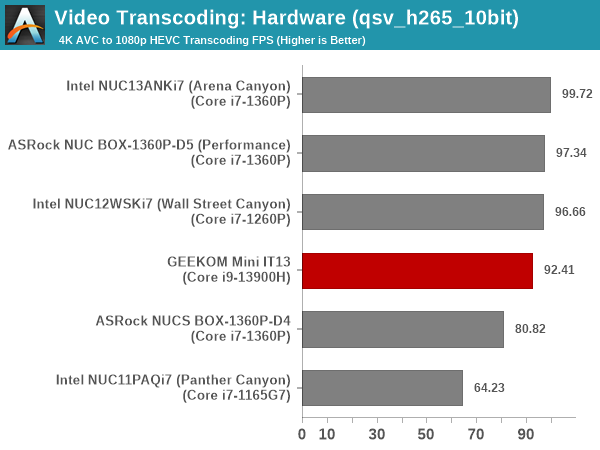
Hardware transcoding performance using QuickSync depends on the iGPU clock rates, which in turn depends on the available power budget for long-term tasks. The improvements over Tiger Lake ensure that the Mini IT13 is able to show a 40%+ improvement over the Panther Canyon NUC. However, against the 40W PL1 configurations in both Rocket Lake and Alder Lake, the 35W PL1 settings prove to be a detriment. This keeps the Mini IT13 in the lower half of the pack.
Archiving: 7-Zip 21.7
The 7-Zip benchmark is carried over from our previous test suite with an update to the latest version of the open source compression / decompression software.
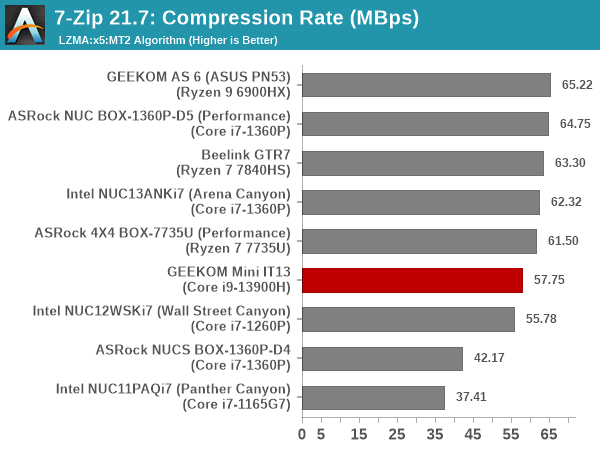

Despite the higher core count, the Mini IT13 is let down by the 35W PL1. This pushes it below the 40W PL1 configuration of the RPL-P systems. The Beelink GTR7 with its 65W octa-core Phoenix APU is the obvious leader in the compression chart. The trend repeats for the decompression case, except that the Mini IT13 is able to have a slight edge over the ASRock Industrial NUC BOX-1360P/D5. While the compression chart sees the Mini IT13 in the lower half, the decompression case puts it right in the middle.
Web Browsing: JetStream, Speedometer, and Principled Technologies WebXPRT4
Web browser-based workloads have emerged as a major component of the typical home and business PC usage scenarios. For headless systems, many applications based on JavaScript are becoming relevant too. In order to evaluate systems for their JavaScript execution efficiency, we are carrying over the browser-focused benchmarks from the WebKit developers used in our notebook reviews. Hosted at BrowserBench, JetStream 2.0 benchmarks JavaScript and WebAssembly performance, while Speedometer measures web application responsiveness.
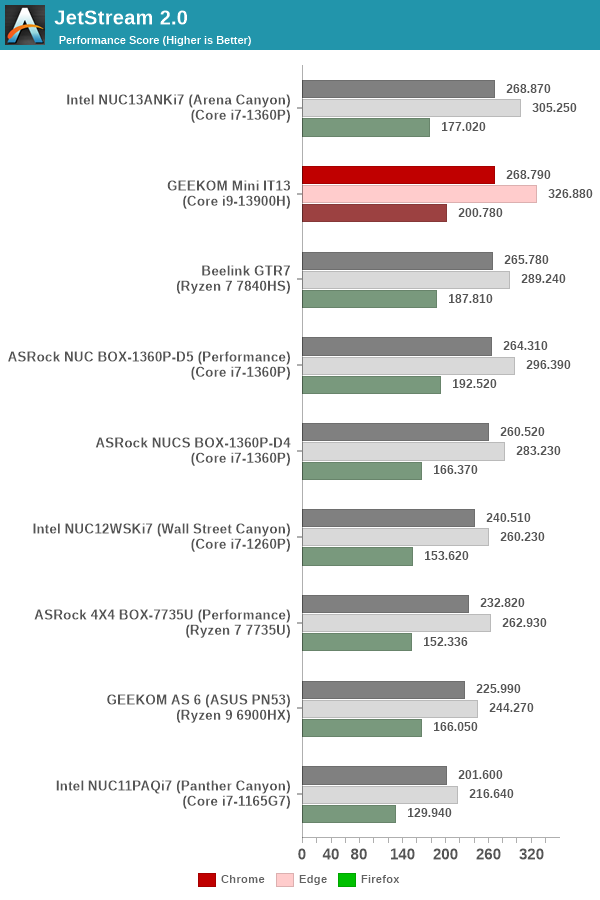
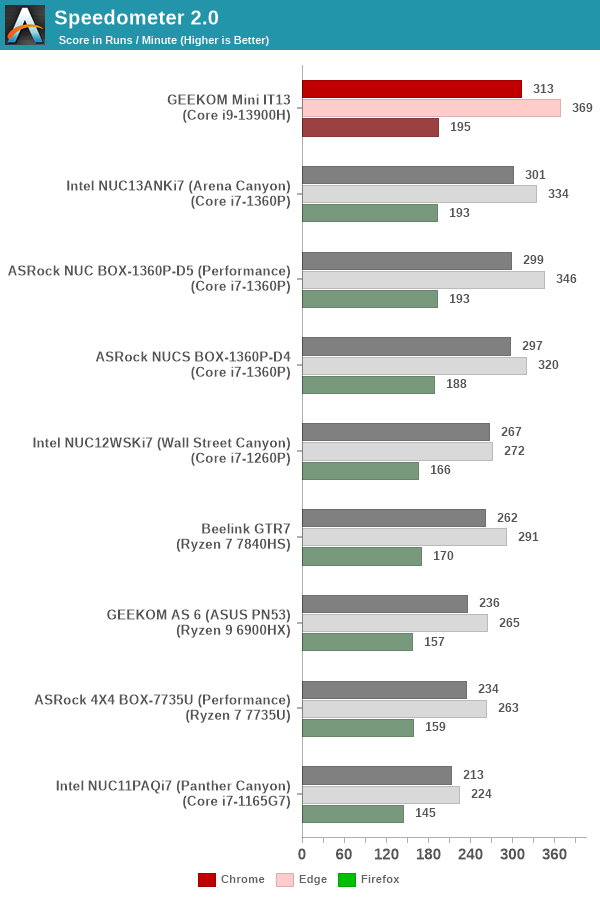
From a real-life workload perspective, we also process WebXPRT4 from Principled Technologies. WebXPRT4 benchmarks the performance of some popular JavaScript libraries that are widely used in websites.
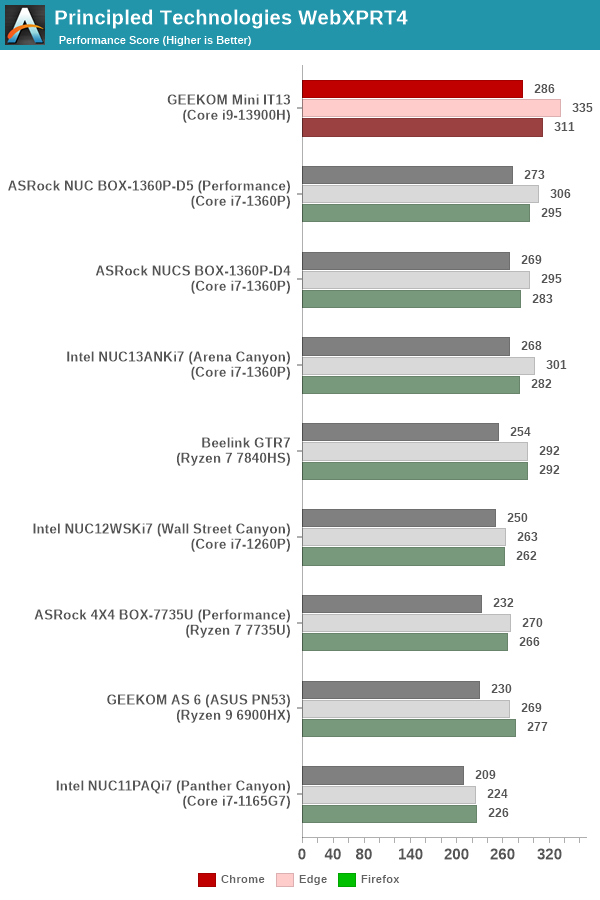
The trifecta of browser benchmarks is where the single-threaded performance of the Core i9-13900H comes to fore. The Mini IT13 actually turns up on top in all three of the benchmarks despite the lower PL1 setting. The workload characteristics are such that the short bursts of high clock speeds turn out to be good – particularly for real-world web browser workloads like WebXPRT4.
Application Startup: GIMP 2.10.30
A new addition to our systems test suite is AppTimer – a benchmark that loads up a program and determines how long it takes for it to accept user inputs. We use GIMP 2.10.30 with a 50MB multi-layered xcf file as input. What we test here is the first run as well as the cached run – normally on the first time a user loads the GIMP package from a fresh install, the system has to configure a few dozen files that remain optimized on subsequent opening. For our test we delete those configured optimized files in order to force a ‘fresh load’ every second time the software is run.
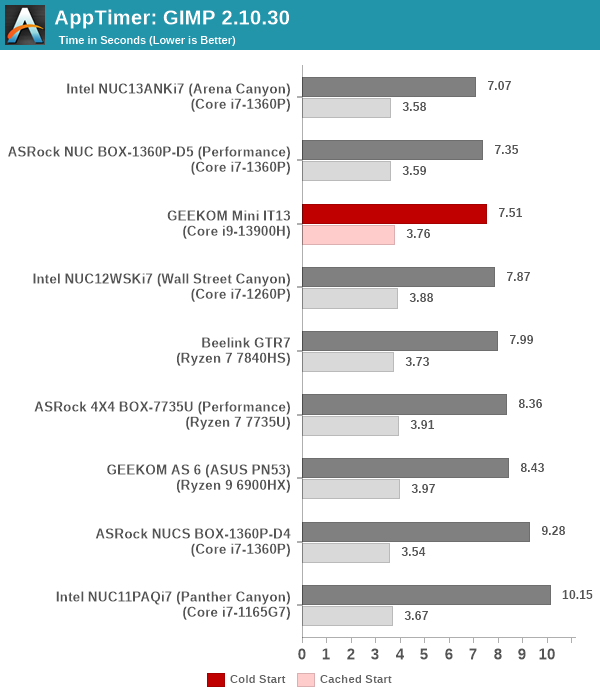
As it turns out, GIMP does optimizations for every CPU thread in the system, which requires that higher thread-count processors take a lot longer to run. So the test runs quick on systems with fewer threads, however fast cores are also needed. The Raptor Lake systems with four cores perform the best in both cases, with the two additional cores possibly causing the Mini IT13 to slip down a bit.
Cryptography Benchmarks
Cryptography has become an indispensable part of our interaction with computing systems. Almost all modern systems have some sort of hardware-acceleration for making cryptographic operations faster and more power efficient. In the case of IoT servers, many applications – including web server functionality and VPN – need cryptography acceleration.
BitLocker is a Windows features that encrypts entire disk volumes. While drives that offer encryption capabilities are dealt with using that feature, most legacy systems and external drives have to use the host system implementation. Windows has no direct benchmark for BitLocker. However, we cooked up a BitLocker operation sequence to determine the adeptness of the system at handling BitLocker operations. We start off with a 4.5GB RAM drive in which a 4GB VHD (virtual hard disk) is created. This VHD is then mounted, and BitLocker is enabled on the volume. Once the BitLocker encryption process gets done, BitLocker is disabled. This triggers a decryption process. The times taken to complete the encryption and decryption are recorded. This process is repeated 25 times, and the average of the last 20 iterations is graphed below.
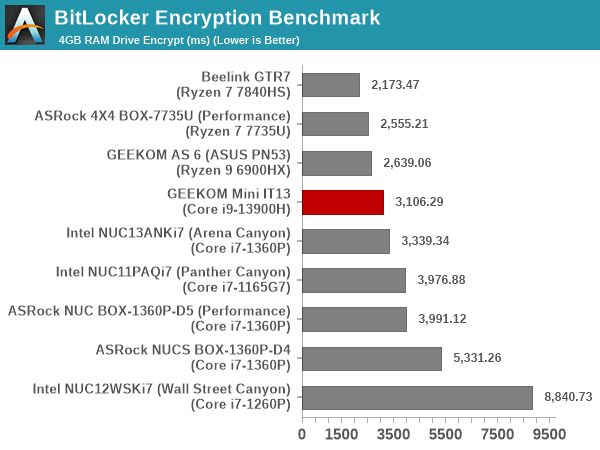
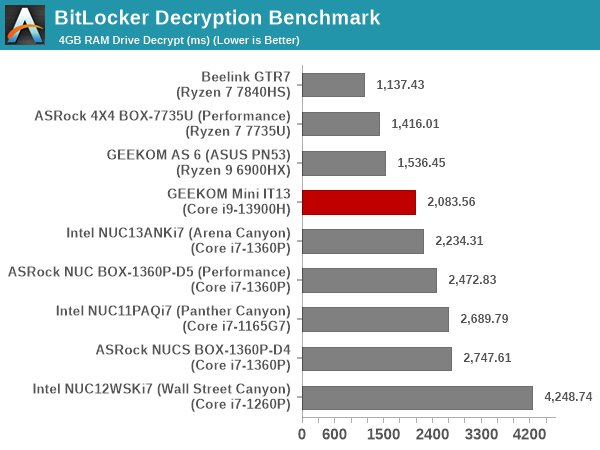
Hardware acceleration is available for the operations in all of the systems. The time taken for processing is directly dependent on the number of available cores, and within the same core count – the available power budget. It must be noted that the AMD-based systems enjoying a distinct advantage over the Intel ones in this department.
Intel did not make significant changes in the integrated GPU when moving from Alder Lake to Raptor Lake. Process maturity has allowed it to clock the iGPU a bit higher, but the number of EUs remains the same as in the previous generation. GPU performance evaluation typically involved gaming workloads, and for select PCs, GPU compute. Prior to that, we wanted to take a look at the capabilities of the iGPU in the Core i9-13900H. With 80 EUs, the iGPU is not the top-end in the Raptor Lake family (which goes up to 96 EUs). However, the extra power headroom allows it to clock as high as 1500 MHz.
The Intel Iris Xe Graphics in the GEEKOM Mini IT13 is essentially a couple of generations old, and that reflects in the benchmarks below.
GFXBench
The DirectX 12-based GFXBench tests from Kishonti are cross-platform, and available all the way down to smartphones. As such, they are not very taxing for discrete GPUs and modern integrated GPUs. We processed the offscreen versions of the ‘Aztec Ruins’ benchmark.
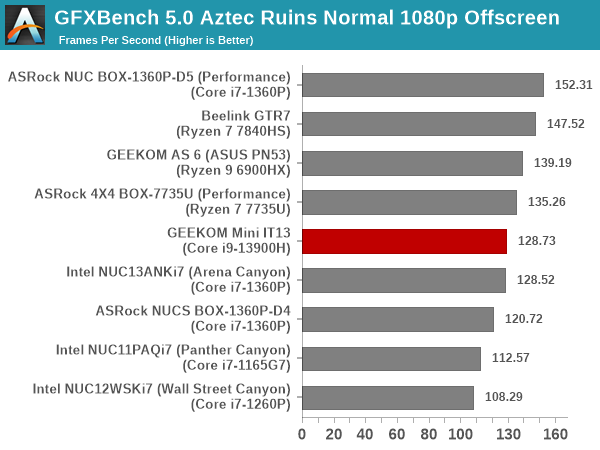

The performance of the GEEKOM Mini IT13 in both workloads is similar to that of the Arena Canyon NUC. This is expected because the hardware configuration of the iGPU of the Core i7-1360P and the Core i9-13900H are very similar. The new crop of RDNA-based iGPUs in the Ryzen mobile SoCs make up the top of the pack.
UL 3DMark
Four different workload sets were processed in 3DMark – Fire Strike, Time Spy, Night Raid, and Wild Life.
The Fire Strike benchmark has three workloads. The base version is meant for high-performance gaming PCs. It uses DirectX 11 (feature level 11) to render frames at 1920 x 1080. The Extreme version targets 1440p gaming requirements, while the Ultra version targets 4K gaming system, and renders at 3840 x 2160. The graph below presents the overall score for the Fire Strike Extreme and Fire Strike Ultra benchmark across all the systems that are being compared.
| UL 3DMark – Fire Strike Workloads | |||

The Time Spy workload has two levels with different complexities. Both use DirectX 12 (feature level 11). However, the plain version targets high-performance gaming PCs with a 2560 x 1440 render resolution, while the Extreme version renders at 3840 x 2160 resolution. The graphs below present both numbers for all the systems that are being compared in this review.
| UL 3DMark – Time Spy Workloads | |||

The Wild Life workload was initially introduced as a cross-platform GPU benchmark in 2020. It renders at a 2560 x 1440 resolution using Vulkan 1.1 APIs on Windows. It is a relatively short-running test, reflective of mobile GPU usage. In mid-2021, UL released the Wild Life Extreme workload that was a more demanding version that renders at 3840 x 2160 and runs for a much longer duration reflective of typical desktop gaming usage.
| UL 3DMark – Wild Life Workloads | |||
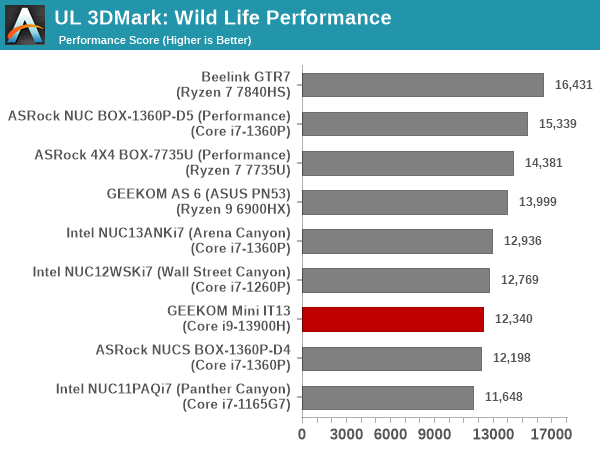
The Night Raid workload is a DirectX 12 benchmark test. It is less demanding than Time Spy, and is optimized for integrated graphics. The graph below presents the overall score in this workload for different system configurations.
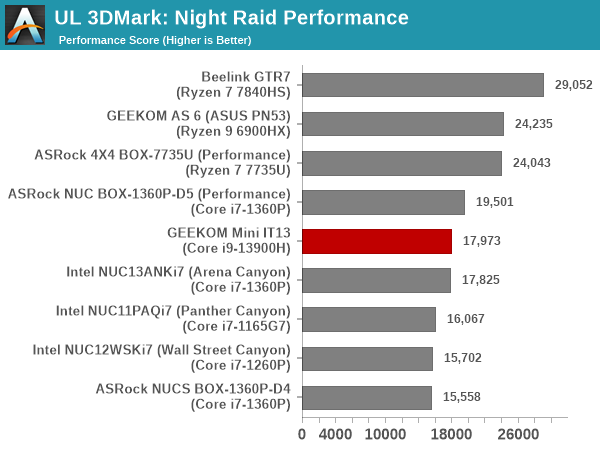
The relative performance of the GEEKOM Mini IT13 across almost all of the 3DMark workloads is the same as what was observed in the GFXbench workloads. The AMD-based systems come out on top and the Mini IT13 performs similar to that of the Arena Canyon NUC. The lower overall power budget affects the Mini IT13 negatively in the 3D Mark Wild Life workloads that involves Vulkan APIs, but DirectX 12-based workloads result in the expected ordering based on the paper specifications.
One of the key drivers of advancements in computing systems is multi-tasking. On mobile devices, this is quite lightweight – cases such as background email checks while the user is playing a mobile game are quite common. Towards optimizing user experience in those types of scenarios, mobile SoC manufacturers started integrating heterogenous CPU cores – some with high performance for demanding workloads, while others were frugal in terms of both power consumption / die area and performance. This trend is now slowly making its way into the desktop PC space.
Multi-tasking in typical PC usage is much more demanding compared to phones and tablets. Desktop OSes allow users to launch and utilize a large number of demanding programs simultaneously. Responsiveness is dictated largely by the OS scheduler allowing different tasks to move to the background. The processor is required to work closely with the OS thread scheduler to optimize performance in these cases. Keeping these aspects in mind, the evaluation of multi-tasking performance is an interesting subject to tackle.
We have augmented our systems benchmarking suite to quantitatively analyze the multi-tasking performance of various platforms. The evaluation involves triggering a ffmpeg transcoding task to transform 1716 3840×1714 frames encoded as a 24fps AVC video (Blender Project’s ‘Tears of Steel’ 4K version) into a 1080p HEVC version in a loop. The transcoding rate is monitored continuously. One complete transcoding pass is allowed to complete before starting the first multi-tasking workload – the PCMark 10 Extended bench suite. A comparative view of the PCMark 10 scores for various scenarios is presented in the graphs below. Also available for concurrent viewing are scores in the normal case where the benchmark was processed without any concurrent load, and a graph presenting the loss in performance.
| UL PCMark 10 Load Testing – Digital Content Creation Scores | |||
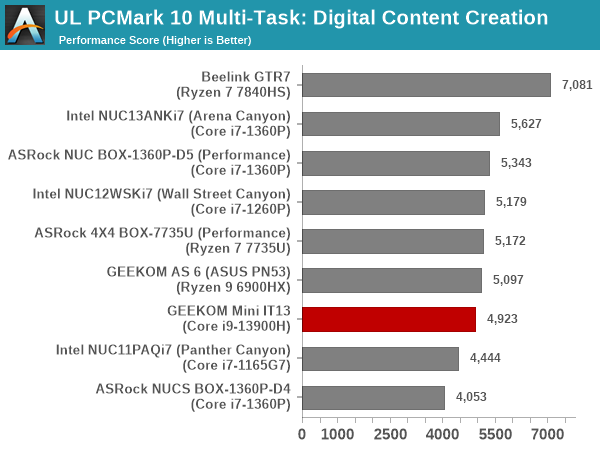
| UL PCMark 10 Load Testing – Productivity Scores | |||
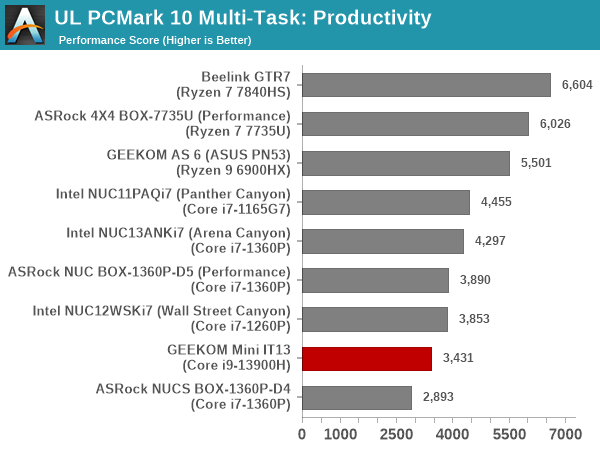
| UL PCMark 10 Load Testing – Essentials Scores | |||

| UL PCMark 10 Load Testing – Gaming Scores | |||
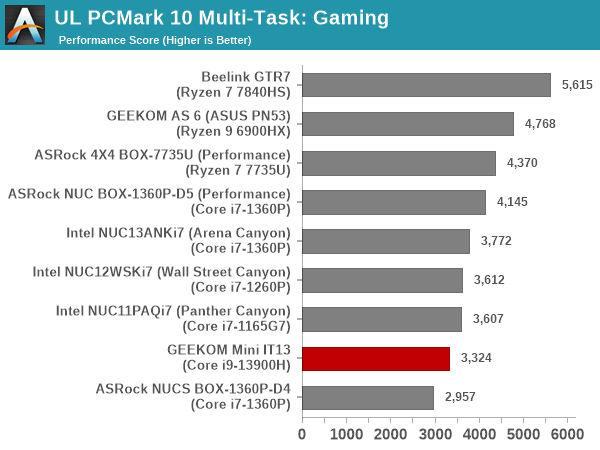
| UL PCMark 10 Load Testing – Overall Scores | |||

Addition of concurrent loading obviously reduces the PCMark 10 scores. The 4P + 8e configurations appear to handle concurrent loading better than the 6P + 8e configuration in the GEEKOM Mini IT13. This results in the systems based on the Core i7-1360P / Core i7-1260P getting ahead of the Mini IT13 when the concurrent loading is active.
Following the completion of the PCMark 10 benchmark, a short delay is introduced prior to the processing of Principled Technologies WebXPRT4 on MS Edge. Similar to the PCMark 10 results presentation, the graph below show the scores recorded with the transcoding load active. Available for comparison are the dedicated CPU power scores and a measure of the performance loss.
| Principled Technologies WebXPRT4 Load Testing Scores (MS Edge) | |||

The GEEKOM Mini IT13 had the best WebXPRT4 scores in the traditional benchmarking routine. However, with the addition of the concurrent loading, the performance drop is precipitous. The system barely manages to avoid scraping the bottom of the barrel, with most of the power budget getting devoted to the transcoding task.
The final workload tested as part of the multitasking evaluation routine is CINEBENCH R23.
| 3D Rendering – CINEBENCH R23 Load Testing – Single Thread Score | |||

| 3D Rendering – CINEBENCH R23 Load Testing – Multiple Thread Score | |||

The single-threaded rendering case is negatively affected in a manner similar to that of WebXPRT4. The Mini IT13 ends up in the bottom half of the pack. However, the multi-threaded case sees better behavior and the relative ordering of the systems between the load on / off scenarios is similar.
After the completion of all the workloads, we let the transcoding routine run to completion. The monitored transcoding rate throughout the above evaluation routine (in terms of frames per second) is graphed below.
| GEEKOM Mini IT13 (Intel Core i9-13900H) ffmpeg Transcoding Rate (Multi-Tasking Test) | |||
| Task Segment | Transcoding Rate (FPS) | ||
| Minimum | Average | Maximum | |
| Transcode Start Pass | 4 | 13.91 | 49 |
| PCMark 10 | 0 | 12.51 | 39 |
| WebXPRT 4 | 3 | 12.84 | 39 |
| Cinebench R23 | 3 | 12.52 | 40 |
| Transcode End Pass | 3.5 | 13.8 | 38 |
On the positive side, the drop in transcoding frame rate for the GEEKOM Mini IT13 is not as heavy as what was seen for the AMD-based systems. The ‘thread director’ scheme appears to work better for the 4P + 8e systems compared to the 6P + 8e configuration in the Mini IT13, but this aspect seems important only in the case of systems with limited power budgets. We see that the Beelink GTR7 with its 65W Ryzen 7 7840HS has a much lower delta in the graphs above.
The 2022 Q4 update to our system reviews brings an updated HTPC evaluation suite for systems. After doing away with the evaluation of display refresh rate stability and Netflix streaming evaluation, the local media playback configurations have also seen a revamp. This section details each of the workloads processed on the GEEKOM Mini IT13 as part of the HTPC suite.
YouTube Streaming Efficiency
YouTube continues to remain one of the top OTT platforms, primarily due to its free ad-supported tier. Our HTPC test suite update retains YouTube streaming efficiency evaluation as a metric of OTT support in different systems. Mystery Box’s Peru 8K HDR 60FPS video is the chosen test sample. On PCs running Windows, it is recommended that HDR streaming videos be viewed using the Microsoft Edge browser after putting the desktop in HDR mode.
The GPU in GEEKOM Mini IT13 supports hardware decoding of VP9 Profile 2, and we see the stream encoded with that codec being played back. The streaming is perfect, thanks to the powerful GPU and hardware decoding support – the few dropped frames observed in the statistics below are due to mouse clicks involved in bringing up the overlay.
The streaming efficiency-related aspects such as GPU usage and at-wall power consumption are also graphed below.

The system is fairly energy efficient – matching that of the ASRock Industrial NUC BOX-1360P/D5 in that aspect. It is likely that driver improvements have been made since we tested the Arena Canyon NUC, and that results in the improved energy efficiency of the Mini IT13 / NUC BOX-1360P/D5 with similar iGPU configurations.
Hardware-Accelerated Encoding and Decoding
TThe transcoding benchmarks in the systems performance section presented results from evaluating the QuickSync encoder within Handbrake’s framework. The capabilities of the decoder engine are brought out by DXVAChecker.

Video Decoding Hardware Acceleration in GEEKOM Mini IT13
The iGPU in the Core i9-13900H supports hardware decode for a variety of codecs including AVC, JPEG, HEVC (8b and 10b, 4:2:0 and 4:4:4), and VP9 (8b and 10b, 4:2:0 and 4:4:4). AV1 decode support is also present. This is currently the most comprehensive codec support seen in the PC space.
Local Media Playback
Evaluation of local media playback and video processing is done by playing back files encompassing a range of relevant codecs, containers, resolutions, and frame rates. A note of the efficiency is also made by tracking GPU usage and power consumption of the system at the wall. Users have their own preference for the playback software / decoder / renderer, and our aim is to have numbers representative of commonly encountered scenarios. Our Q4 2022 test suite update replaces MPC-HC (in LAV filters / madVR modes) with mpv. In addition to being cross-platform and open-source, the player allows easy control via the command-line to enable different shader-based post-processing algorithms. From a benchmarking perspective, the more attractive aspect is the real-time reporting of dropped frames in an easily parseable manner. The players / configurations considered in this subsection include:
- VLC 3.0.18
- Kodi 20.2
- mpv 0.35.1 (hwdec auto, vo=gpu-next)
- mpv 0.35.1 (hwdec auto, vo=gpu-next, profile=gpu-hq)
Fourteen test streams (each of 90s duration) were played back from the local disk with an interval of 30 seconds in-between. Various metrics including GPU usage, at-wall power consumption, and total energy consumption were recorded during the course of this playback.
All our playback tests were done with the desktop HDR setting turned on. It is possible for certain system configurations to automatically turn on/off the HDR capabilities prior to the playback of a HDR video, but, we didn’t take advantage of that in our testing.
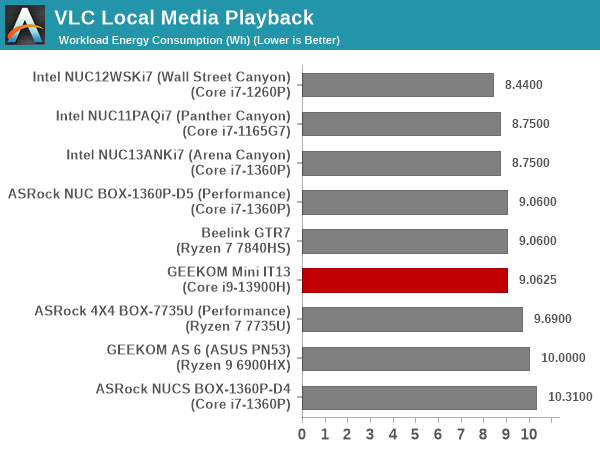
Playback was perfect for all codecs except AV1 (the CPU is not strong enough for software-only 8Kp60 decoding), and the power consumption numbers are excellent. The energy consumption numbers land the Mini IT13 in the middle of the pack, but there is not much separating the system from the most efficient ones in the above graph.

The scenario seen with VLC is replicated in Kodi also – no proper AV1 playback, but energy numbers good enough to put the Mini IT13 in the middle of the pack.

mpv playback with the gpu-next video output driver is reasonably energy efficient. We also have hardware accelerated decode for AV1. However, the playback for that clip still has issues, with more than half of the frames getting dropped in the video output (the decoder itself doesn’t drop any frames).

Putting additional stress on the GPU shaders for video post processing does result in increased energy consumption, but there are no dropped frames. The relative positions in the energy consumption graph remain the same. The 8Kp60 AV1 decode video output issue remains the same irrespective of the used profile.
The power consumption at the wall was measured with a 4K display being driven through the HDMI port of the system. In the graph below, we compare the idle and load power of the GEEKOM Mini IT13 with other systems evaluated before. For load power consumption, we ran the AIDA64 System Stability Test with various stress components, as well as our custom stress test with Prime95 / Furmark, and noted the peak as well as idling power consumption at the wall.
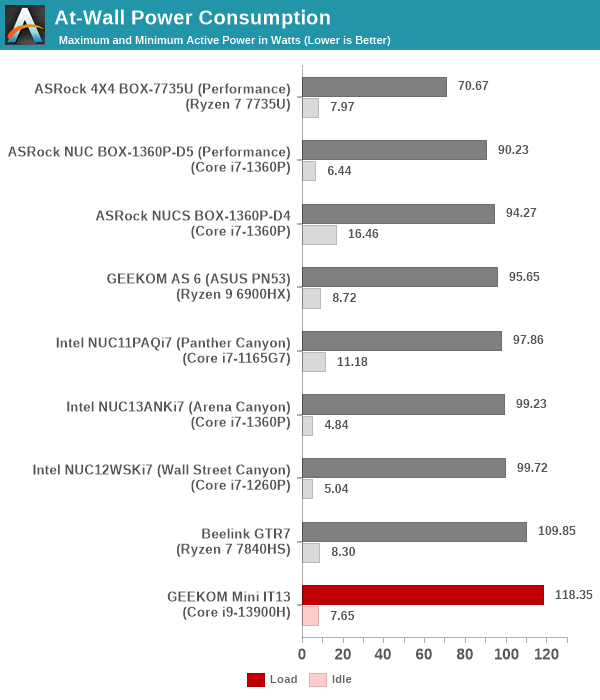
The numbers are consistent with the configured PL1 / PL2 of 35W / 80W for the Core i9-13900H in the Mini IT13. On the idling front, the system is not able to meet the efficiency benchmark set by the Intel NUCs, but manages to better other DDR4-based RPL-P systems such as the ASRock Industrial NUCS BOX-1360P/D4.
Stress Testing
Our thermal stress routine is a combination of Prime95, Furmark, and Finalwire’s AIDA64 System Stability Test. The following 9-step sequence is followed, starting with the system at idle:
- Start with the Prime95 stress test configured for maximum power consumption
- After 30 minutes, add Furmark GPU stress workload
- After 30 minutes, terminate the Prime95 workload
- After 30 minutes, terminate the Furmark workload and let the system idle
- After 30 minutes of idling, start the AIDA64 System Stress Test (SST) with CPU, caches, and RAM activated
- After 30 minutes, terminate the previous AIDA64 SST and start a new one with the GPU, CPU, caches, and RAM activated
- After 30 minutes, terminate the previous AIDA64 SST and start a new one with only the GPU activated
- After 30 minutes, terminate the previous AIDA64 SST and start a new one with the CPU, GPU, caches, RAM, and SSD activated
- After 30 minutes, terminate the AIDA64 SST and let the system idle for 30 minutes
Traditionally, this test used to record the clock frequencies – however, with the increasing number of cores in modern processors and fine-grained clock control, frequency information makes the graphs cluttered and doesn’t contribute much to understanding the thermal performance of the system. The focus is now on the power consumption and temperature profiles to determine if throttling is in play.
The cooling solution for the processor package is effective, and the package power doesn’t dip below the PL1 value of 35W throughout the duration in which it is stressed. The iGPU alone seems to have a power budget of around 25W. That said, the PL2 value of 80W doesn’t appear reasonable for the cooling solution, as the temperature approaches 100C+ within a couple of seconds of load application, as shown in the graph below.
The limitations of the cooling solution are also evident during the pure GPU loading phase. Allocating 25W to the iGPU segment of the die results in the package temperature again touching 100C+ before the thermal solution can catch up. As part of this process, the iGPU does undergo intermittent throttling.
Based on our evaluation of the thermal solutions for different small form-factor systems, it appears that a 35W or 40W TDP solution meant for a quad-core processor might not be really effective at handling that package power for a hexa-core or octa-core one.
Networking and storage are aspects that may be of vital importance in specific PC use-cases. The GEEKOM Mini IT13 comes with an Intel AX211 Wi-Fi 6E / Bluetooth 5.2 controller and an Intel I225-V 2.5G BASE-T solution. The system also includes USB4 with PCIe tunneling support – so it is easy to add external Thunderbolt-based solutions for additional high-speed networking capabilities.
On the storage side, the GEEKOM Mini IT13 came pre-configured with a Lexar SSD NM7A1 2TB M.2 2280 PCIe 4.0 x4 NVMe SSD. It uses a Maxio MAP1602 DRAM-less 4-channel controller. The SSD is a double-sided one, likely using Micron’s 176L 3D TLC (based on the flash package markings). The SSD includes a dedicated thermal solution with a thermal pad affixed to the metal frame. Based on the construction, we should likely not be seeing any thermal throttling during usage. The system can also accommodate a 2.5″ 7mm drive and a M.2 2242 SATA SSD. From a benchmarking perspective, we provide results from the WPCstorage test of SPECworkstation 3.1. This benchmark replays access traces from various programs used in different verticals and compares the score against the one obtained with a 2017 SanDisk 512GB SATA SSD in the SPECworkstation 3.1 reference system.
| SPECworkstation 3.1.0 – WPCstorage SPEC Ratio Scores | |||
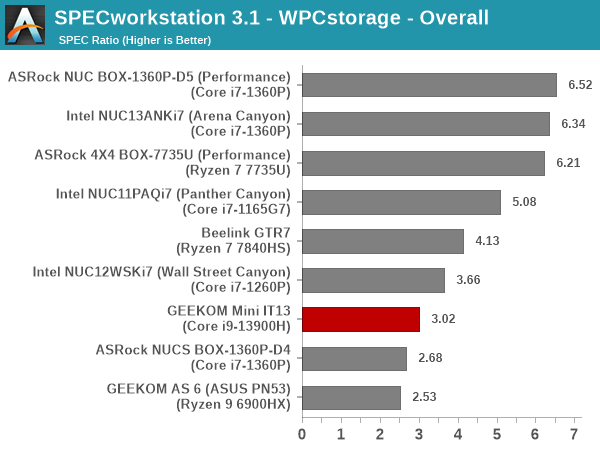
The graphs above present results for different verticals, as grouped by SPECworkstation 3.1. The storage workload consists of 60 subtests. Access traces from CFD solvers and programs such as Catia, Creo, and Soidworks come under ‘Product Development’. Storage access traces from the NAMD and LAMMPS molecular dynamics simulator are under the ‘Life Sciences’ category. ‘General Operations’ includes access traces from 7-Zip and Mozilla programs. The ‘Energy’ category replays traces from the energy-02 SPECviewperf workload. The ‘Media and Entertainment’ vertical includes Handbrake, Maya, and 3dsmax. The overall rating puts the Lexar NM7A1 in the lower half of the pack – having gotten surpassed by systems equipped with SSDs using their own DRAM for the flash translation layer (FTL).
Closing Thoughts
The GEEKOM Mini IT13 provided us with the opportunity to evaluate one of the first Core i9-based UCFF systems in the market. It is loaded with premium features including two full-featured USB4 ports. Having put many Raptor Lake-P systems through our rigorous evaluation, a Raptor Lake-H one provided a slightly different perspective. The Core i9-based system excels in specific tasks such as web browsing that can make good use of the boost clocks and rely on single-threaded performance. However, for the vast majority of office workloads and the like, the addition of two performance cores within a thermally constrained system provides no tangible benefit.
GEEKOM’s systems have traditionally adopted a conservative approach to configuring package power limits for their systems. We saw that the GEEKOM AS 6‘s Ryzen 9 6900HX was configured with a 35W package power limit. The Mini IT13 is also configured similarly, despite its slightly smaller footprint. Based on our benchmarking results, it appears that the Core i9-13900H needs a 45W PL1 configuration to bring out its capabilities. While both Intel and ASRock Industrial’s Raptor Lake-P UCFF systems have the SoC configured for 40W PL1, the conservative 35W setting by GEEKOM reflects negatively on the performance. The silver lining is that the fan noise is not overwhelming. GEEKOM also has an even more conservative ‘Quiet’ mode in the BIOS that reduces the PL1 to 28W.
There is no doubt that the GEEKOM Mini IT13 is equipped with the optimal set of I/O interfaces. Packing six high performance and four efficiency cores into a 4×4 package makes for an interesting product. However, prospective purchasers need to tune their performance expectations keeping the power budget in mind.
The GEEKOM Mini IT13’s pricing makes it a winner from a value proposition perspective. The system is currently available for US $889 (2TB SSD / 32GB RAM / Windows 11 Pro) (USD 849 with $40 off coupon code D9ZAYQNX) / US $789 (2TB SSD / 32GB RAM / Windows 11 Pro, GEEKOM web store) (USD 749 with $40 off coupon code anandtech40). Compared to the barebones ASRock Industrial NUC BOX-1360P/D5 at $670 and the Intel NUC13ANHi7 at $699, the addition of the SSD, RAM, and OS license for less than $100 (while also adding two high-performance cores) represents significant value for the end user.
In terms of scope for improvement, we would have liked to see the system come with DDR5 SODIMM support instead of DDR4. Additional focus on the PL1 settings could have resulted in a system that could deliver on both performance and value proposition. As it stands currently, the GEEKOM Mini IT13 is a compelling system that combines an optimal feature set with a rather unique processor for a UCFF desktop. As long as the end user is aware of the tradeoffs involved (lower sustained package power), the investment is bound to be a satisfactory one.

